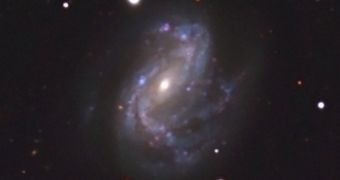Pollution on Earth is a very real threat to all lifeforms and its negative effects on organisms are well known, so countermeasures will have to be taken, if we all want to survive on the Blue Planet as we did before.
Did you known there is such thing as "intergalactic pollution"?
Warm gas escaping from the clutches of enormous black holes could be the element that made life possible, according to new results from ESA's XMM-Newton space observatory.
Black holes have been speculated to do a lot of things in science, and even more in science-fiction, from absorbing light and the life of nearby planets and stars, to making time-travel possible. Now, it seems they are also responsible for making life itself possible.
An international team of astronomers, led by Yair Krongold, Instituto de Astronomia, Universidad Nacional Autonoma de Mexico, targeted a black hole two million times more massive than the Sun at the center of the active galaxy NGC 4051. Previous observations had only revealed the average properties of the escaping gas. XMM-Newton has the special ability to watch a single celestial object with several instruments at the same time. With this, the team collected more detailed information about variations in the gas' brightness and ionization state.
Before reaching the boundary of the black hole known as the Event Horizon, gas can escape if heated sufficiently. The team saw that the gas was escaping from much closer to the black hole than previously thought. They could determine the fraction of gas that was escaping. "We calculated that between 25 percent of the accreting material is flowing back out," says team member Fabrizio Nicastro, Harvard-Smithsonian Centre for Astrophysics. This was less than some astronomers had expected.
The warm gas contains chemical elements heavier than Hydrogen and Helium. Astronomers term them "metals" since they are elements in which electrons are ripped away and they have positive ionization states - like metals. They include carbon, the essential element for life on Earth. These metals can only be made inside stars, yet they pollute vast tracts of space between galaxies. Astronomers have long wondered how they arrived in intergalactic space.
Quasars might provide a clue. They are galaxy nuclei, and an astronomical source of electromagnetic energy, but no one expected them to also produce mass.
Feeding voraciously, they must have been escaping gas that could carry metals all the way into the intergalactic space. If quasars are responsible for spraying metals into intergalactic space, the pollution would more likely be found in bubbles surrounding each quasar. So, different parts of the Universe would be enriched with metals at different speeds. This may explain why astronomers see differing quantities of metals depending upon the direction in which they look.
"Based on this one measurement, quasars can contribute some but not all of the metals to the intergalactic medium," says Krongold, but scientists will have to continue the investigations to determine whether the fraction of gas escaping in more powerful galaxies, like Ultra Luminous Infra Red Galaxies, changes or stays the same. If the fraction goes up, they will have solved the puzzle. If it stays the same, the search will have to continue.

 14 DAY TRIAL //
14 DAY TRIAL //